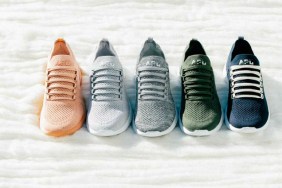Nina Marenzi came to sustainable textiles via a Masters degree in Sustainable Agriculture and Rural Development, for which she wrote a dissertation titled, “Organic Cotton: Reasons Why the Fashion Industry is Dragging its Heels.” In her many interviews with fashion designers, industry insiders NGOs and academics, it became clear that there was a definite need for a platform to exhibit fashionable, high-quality and commercially sustainable fabrics, where sourcing such fabrics could be made easy and where information about sustainability in fashion would be available. Fashion designers needed to be shown that the ‘woolly’ image of eco-fabrics was long outdated. And so, the Future Fabrics Expo was born as a project of The Sustainable Angle, which was initiated in 2010 with the aim to support the reduction of environmental impact caused by industry, most notably addressing the fashion industry’s impact.

Below, John Patrick, the designer behind the brand Organic and theFashionSpot’s April guest editor, speaks with Marenzi about The Sustainable Angle, the organization’s collaboration with Nike and why sustainable fabrics are the future of fashion.
John Patrick: How has the Sustainable Angle’s mission evolved since you first launched?
Nina Marenzi: The Sustainable Angle has been successful in contributing to changing the outdated image of sustainable materials, building up an expanding resource of individually assessed fabrics which are suitable for luxury, mainstream and niche brands, sourced from global mills with a commitment to improved business practices and environmental standards. Especially since 2013, we have seen several other organizations in Italy and Denmark, for example, setting up places where sustainable fabrics can be sourced. Since our launch, we had to extend our yearly showcase to go online due to high demand from international fashion designers looking for sustainable fabrics. Plus, the mills were looking for opportunities to be introduced to our extensive database of fashion brands all year round.

JP: How did your collaboration with Nike come about? What was the outcome?
NM: The LAUNCH initiative is an interesting cooperation of NASA, USAID, Nike and the U.S. Department of State, with its focus last year on materials. To us it made sense to support their “quest to maximize human potential [which requires] the collaboration and commitments of government, corporations, investment, sustainability and global development organizations to accelerate innovation and convert ideas into action around the world.” One of the outcomes of LAUNCH 2013 were the selection of several interesting materials, it remains to be seen though if they will make tangible impacts on society.
JP: Did you have any hesitation about working with a major conglomorate?
NM: The Sustainable Angle supports projects which have been initiated by big and small brands, as long as they make sense to us and are in line with our aims. Of course it is more difficult with big conglomerates as not all what they do is identical to what we believe in.

JP: In your experience, what are some of the holes in sustainability at design schools?
NM: In the UK there are many fashion and design schools approaching the subject of sustainability, however, a more connected and holistic approach to sustainability is needed. Certainly, the London College of Fashion is progressive and offers good courses on fashion and the environment, but across the board in Europe at least, there is a need for students to get a tangible experience of working with sustainable fabrics. Fabrics libraries in design schools are often not up to date in terms of innovations and fabrics with a lower environmental impact.
JP: What do you think the biggest obstacle is with incorporating organic and sustainable fibers into the supply chains of mid-sized companies?
NM: From what we see, there seems to be a difference between mid-sized companies who do have a mission statement on sustainability and are gradually changing their supply chains to be more responsible and cleaner, and those mid-sized companies who don’t have a strategy to be more sustainable. For the former, once a sustainability strategy is set in place, it quickly becomes apparent that this doesn’t mean that cost increases overall (due to a small increase of the prices of certain fabrics), but rather that across the company, savings follow sustainability. So for example, less wasteful practices are happening, innovations are occurring inside companies spontaneously, so that the small increase of prices in fabrics are offset by a whole range of improvements and savings.
Those companies without a strategy who launch, for example, a small capsule collection that is eco-friendly, generally find the experience difficult and unsatisfactory, as mainly only obstacles appear. Sustainabilty touches on just about every aspect of a company’s business and therefore, if different parts are not aligned, obstacles appear everywhere. Longterm planning and finding the right partners in the textile industry for the longterm (rather than on a seasonal basis), plus having a sustainable strategy at the core of the company makes it possible for even mid-size companies to work with sustainable fabrics. At least that is what we see.
JP: Have you seen an increase or a decrease in the offerings from the mills?
NM: Each season there are more mills with sustainable fabrics in their range. Per mill though, there is only a slow expansion of the range. It is hard to generalize, because we see mills with a really successful sustainable range who find that it was the best strategic decision they could have made. Then there are others who expected a quicker uptake of their eco-friendly fabrics. Hardly any abandon the sustainable range.

JP: In your opinion, will it be the consumer who will facilitate the change in the supply chain or will it be the design and manufacturing industry?
NM: With the resources on our planet being ever more limited — especially water, energy and fertile soil — it is vital to work with raw materials that are renewable, have a lower environmental impact and are responsibly processed in a fair manner. For companies, this means the whole supply chain needs to be shifted — from raw material to end product to end-of-life — whether their customer base is with them or not. The resource constraints will force this change very soon — a look at the water table in China shows this very clearly. Any company without a strategy for a less resource-intensive and more responsible approach is simply doomed. The customer will get this message eventually, but let us hope that this process will be accelerated by society. More education and information is required for society to switch on, and above all the regulator needs to give signals and incentives — integrating the “polluter pays” principle on a governmental level is well overdue. It would accelerate this process on the customer side as well as on the industry side.
All images courtesy Sustainable Angle / Interview in collaboration with Nika Mavrody
Related articles:
Is Sustainability Always Possible?
12 Sustainable Retailers We Love
Watch: “It’s the textile industry that’s really driving the innovation in fashion.” [theFashionDish]
[bamf id=”892623″]






